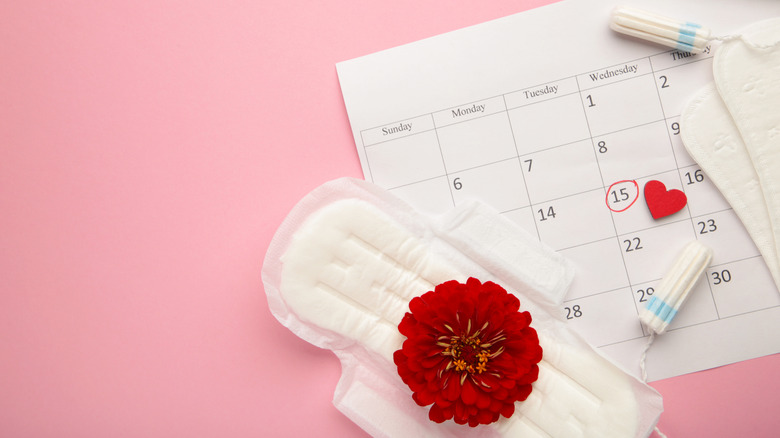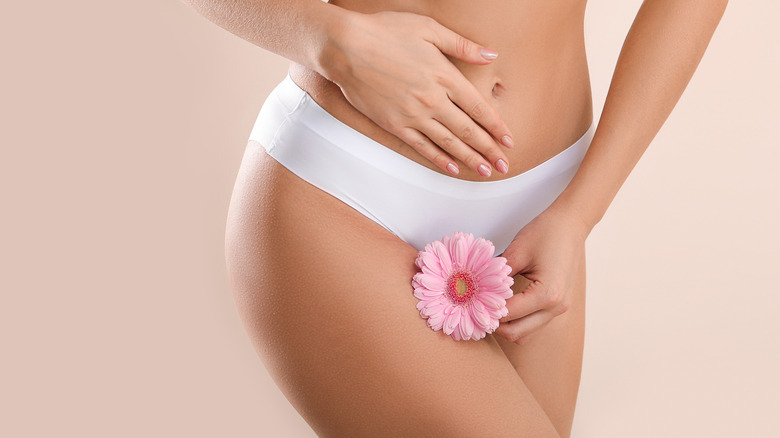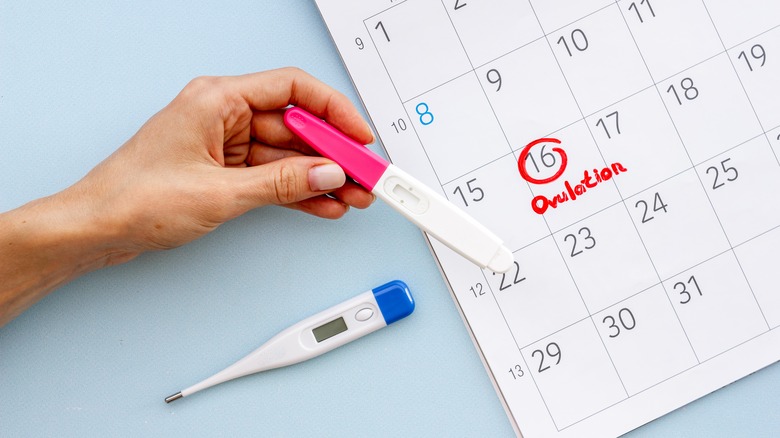The Menstrual Cycle Explained
The menstrual cycle has alternately been viewed as a source of reverence and a cause for shame over the past several millennia, as illustrated in an article from Girls' Globe. Certain cultures around the world have believed people possessed spiritual powers during this time because of their intimate connection to the moon, notes The Guardian. On the other hand, it has also been viewed as a symbol of weakness and pollution. But the menstrual cycle is not only natural, it is essential for the survival of humankind. To remove inappropriate and outdated stigmas from menstruation, we need to talk about it. Here's the menstrual cycle explained.
The menstrual cycle follows four main phases, each unique and laser-focused on a specific physiological action oriented toward achieving pregnancy. Menstruation is the most well-known phase of the complete menstrual cycle, as it is also the most obvious. But the menstrual cycle is a complex process involving many glands, chemicals, hormones, and neural signals (via Better Health), and each of the phases prepares the body for procreation.
Menstruation
When you think about the menstrual cycle, the menstruation phase probably pops into mind first. Menstruation is the menstrual cycle's earliest and most noticeable phase (per Cleveland Clinic). The purpose of menstruation is to flush the uterus of its old lining out through the vaginal opening. Also called menses, this phase is the one that exhibits the most noticeable physical effects. Not only does it include bleeding, but it may also involve bloating, cramping, and breast tenderness. Mood swings and other mental, emotional, and behavioral changes may occur, says Medical News Today.
For thousands of years, people believed menstrual cycles followed the moon's phases. Until recently, full and new moons were linked to menstruation and ovulation. According to an article in Nylon, women who bled during the full moon have been called 'red moon', while women who began menstruating during the new moon were referred to as 'white moon'. However, current data belies this philosophy, and the most extensive study ever done on the subject, conducted by Clue, showed no correlation between lunar cycles and menstruation.
Menstruation usually begins around age 12, but it can start as young as eight or as late as 16. Bleeding usually lasts three to five days, but periods lasting from two to seven days are considered normal, according to the Cleveland Clinic. Periods can continue up until around age 51.
Follicular phase
The follicular phase begins on the first day of menstrual bleeding, and ends with ovulation. This phase prepares eggs for potential fertilization (per Better Health). During the follicular phase, the brain's hypothalamus signals the pituitary gland to stimulate the production of follicles on the ovaries. The pituitary gland releases Follicle Stimulating Hormone (FSH), and as a consequence, the ovaries produce between five and 20 follicles — tiny nodules that form on the surface of the ovaries. Each nodule contains an immature egg, most of which will never mature. One or more eggs will mature and become viable eggs capable of hosting sperm.
The release of follicles stimulates the uterus to thicken its lining, called the endometrium (via Britannica). According to Fertilitypedia, this mucous membrane thickens to provide a surface where a fertilized egg to attach and begin its growth into a fully realized human fetus.
The follicular stage occurs hidden from sight. Most people never think about this crucial stage of the menstrual cycle, focusing instead on menstruation and ovulation to encourage or prevent pregnancy. But Intermountain Healthcare acknowledges the menstrual cycle's follicular phase is critical for ensuring a hospitable environment for a healthy zygote.
Ovulation
According to Intermountain Health, ovulation begins anywhere from 10 to 17 days after the first day of menstruation. After the follicular phase prepares the eggs, estrogen levels peak, triggering a spike in Luteinizing Hormone (LH) levels. These hormonal surges prompt ovulation to begin within 24 to 48 hours. At this point, the strongest follicle released during the follicular phase releases an egg (ovum) from the ovary into a fallopian tube, where sperm can fertilize the ovum.
People seeking to prevent pregnancy using the rhythm method, or trying to get pregnant by tracking maximum fertility during the menstrual cycle, usually rely on signals of ovulation. Body temperature, changes in vaginal secretions, and spikes in LH levels can indicate ovulation has begun.
An egg remains fertile for about one day after release. Sperm, on the other hand, can remain viable for up to three days after ejaculation. Because of sperm's extended shelf-life, peak fertility occurs during the few days before an egg is released.
Luteal phase
After ovulation, the remains of the winning follicle (corpus luteum) that released an egg during the follicular phase trigger a rise in progesterone levels, according to Intermountain Healthcare. This is the beginning of the luteal phase, which continues for around 14 days. During this phase, the corpus luteum signals the body to produce more progesterone in order to stop the production of more eggs and maintain the uterine lining so that a fertilized egg can implant.
Clearblue says pregnancy is possible during the luteal phase, but only for the first day. If an egg is fertilized and the embryo has started to form, a 2021 clinical review explains the new embryo releases human chorionic gonadotropin (hCG), a hormone that sustains the corpus luteum so that it continues to produce progesterone at levels necessary to maintain pregnancy.
If no eggs have been fertilized, the corpus luteum is reabsorbed, causing progesterone levels to drop. This concludes the menstrual cycle because, without the support of progesterone, the uterine lining is shed from the body, causing a new cycle to begin (per Better Health). From the start of one period to the start of the next, an entire menstrual cycle tends to last around 28 days, although cycle length can vary from 21 days to 35 days (per Cleveland Clinic). Unless interrupted by pregnancy or breastfeeding, the cycle naturally repeats until menopause, at which point the menstrual cycle shuts down.
Reclaiming menstruation
If you have a normal menstrual cycle, you might not notice any phase but menstruation, unless you're deliberately tracking ovulation. The Society of Obstetricians and Gynaecologists of Canada notes that people may experience some mild symptoms during normal menstruation, like cramping, headache, bloating, and fatigue. But at some time during your reproductive life, you may experience more intense symptoms.
Premenstrual syndrome (PMS) describes a number of side effects related to menstruation, including mood swings, fatigue, forgetfulness, anxiety, irritability, depression, and more. Not everyone experiences PMS, but according to MGH Center, PMS affects 30-80% of women during their reproductive years. Symptoms are usually mild, but for some people, symptoms can be disruptive to relationships and personal well-being. In this case, it would be a good idea to consult a doctor or psychiatrist.
Even if you experience only mild symptoms during menstruation, it may be a good time to relax and pamper yourself. As Nylon points out, it's okay to indulge in alone time and self-care. So, watch your favorite movies, read a good book, listen to music, sink into a warm bubble bath, journal, or even get a massage at your favorite spa.
The shedding of internal materials that are no longer needed is a perfect time to feel and then release all the worries, shame, and should-have, would-haves of the past month and give yourself permission to just be — wholly sacred, strong, and worthy.






